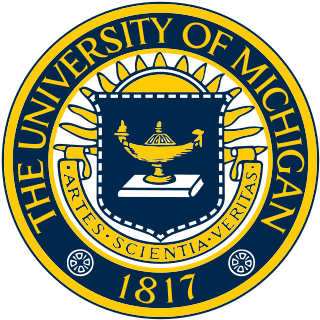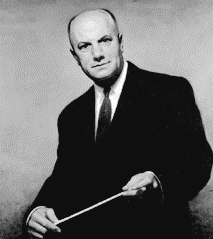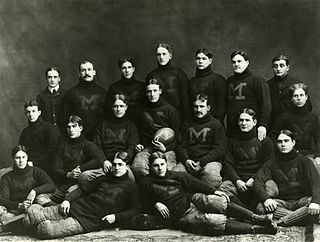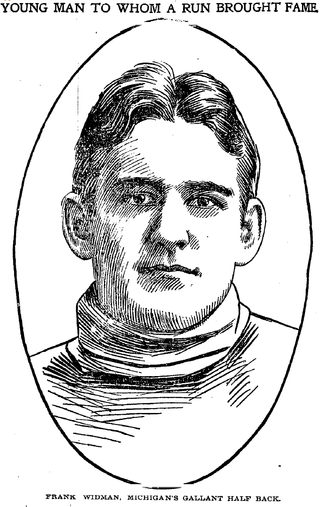
The University of Michigan is a public research university in Ann Arbor, Michigan, United States. Founded in 1817, it is the oldest institution of higher education in the state. The University of Michigan is one of the earliest American research universities and is a founding member of the Association of American Universities. In the fall of 2023, the university employed 8,189 faculty members and enrolled 52,065 students in its programs.
"On, Wisconsin!" is the fight song of the Wisconsin Badgers at the University of Wisconsin–Madison. A version with modified lyrics is the official state song of Wisconsin.

Amos Alonzo Stagg Field is the name of two successive football fields for the University of Chicago. Beyond sports, the first Stagg Field (1893–1957), named for famed coach, Alonzo Stagg, is remembered for its role in a landmark scientific achievement of Enrico Fermi and the Metallurgical Laboratory during the Manhattan Project. The site of the first artificial nuclear chain reaction, which occurred within the field's west viewing-stands structure, received designation as a National Historic Landmark on February 18, 1965. On October 15, 1966, which is the day that the National Historic Preservation Act of 1966 was enacted creating the National Register of Historic Places, it was added to that as well. The site was named a Chicago Landmark on October 27, 1971.

Jake Edward Long is an American former professional football player who was an offensive tackle in the National Football League (NFL). He played college football for the Michigan Wolverines, twice earning consensus All-American honors. Long was selected with the first overall pick by the Miami Dolphins in the 2008 NFL draft. He also played for the St. Louis Rams, Atlanta Falcons and Minnesota Vikings.

The Michigan Marching Band is the official marching band of the University of Michigan. The band performs at all Michigan Wolverines football home games, select away games, and numerous concerts, pep rallies, and parades. A student musical ensemble, the MMB evolved from the original Michigan Band of twenty-two players in 1896 to today's band of over 400 members.
Oskee-Wow-Wow is the official fight song of the University of Illinois at Urbana-Champaign. The song was written in 1910 by two students, Harold Vater Hill, Class of 1911 (1889–1917), credited with the music, and Howard Ruggles Green, Class of 1912 (1890–1969), credited with the lyrics.

The Kansas State University Marching Band, also known as "The Pride of Wildcat Land" or just The Pride, is a 375 piece marching band consisting of woodwinds, brass, percussion, color guard, dancers, and twirlers. It is the official band of Kansas State University.

William D. Revelli was an American music educator and conductor best known for his association with the University of Michigan, where he directed the university's bands including the Michigan Marching Band 1935 to 1971. During his 36 years as director, the Michigan Marching Band won international acclaim for its musical precision. Revelli is also credited with innovations that moved college marching bands across the country away from rigid military formations. Among other things, Revelli’s Michigan Marching Band was the first to synchronize music and movement and the first to use an announcer.

The 1898 Michigan Wolverines football team represented the University of Michigan in the 1898 Western Conference football season. With Gustave Ferbert in his second year as head coach, the team compiled an undefeated 10–0 record, outscored its opponents 205–26, and won the Western Conference championship for the first time in the school's history.

Albert Henderson Pattengill was an American professor of Greek. For 40 years, Pattengill was also a leader in athletics at the University of Michigan. He played on Michigan's 1867 baseball team and was part of a three-person committee that selected "azure-blue and maize" as the university's colors. He was also one of the leaders behind the formation and early development of the Big Ten Conference.

Charles Henry Widman was an American football player and businessman.

The History of Michigan Wolverines football in the early years covers the history of the University of Michigan Wolverines football program from its formation in the 1870s through the hiring of Fielding H. Yost prior to the 1901 season. Michigan was independent of any conference until 1896 when it became one of the founding members of the Western Conference. The team played its home games at the Washtenaw County Fairgrounds from 1883 to 1892 and then at Regents Field starting in 1893.

The Chicago–Michigan football rivalry was an American college football rivalry game played by the Wolverines of the University of Michigan and Maroons of the University of Chicago. From 1892 to 1905, it was the most important game of the season for the two schools, which were the first major football powers in what was then considered the western United States. The rivalry ended after the 1939 season when the University of Chicago dropped out of the Big Ten Conference. The roots of the rivalry date back to 1879 when Michigan played its first intercollegiate football game in Chicago and to a series of matches played between Michigan and the "Chicago University Club" between 1888 and 1891.
"Let's Go Blue" is a short song most often associated with the University of Michigan, but widely performed during high school and professional sports as well. It was composed by Joe Carl and first arranged by Albert Ahronheim in the 1970s. The song consists of 32 bars and is 40 seconds long.
J. Fred Lawton was a lyricist, poet, and businessman active in the greater Detroit area who was closely associated with the University of Michigan for most of his life.
The 1898 Western Conference football season was the third season of college football played by the member schools of the Western Conference and was a part of the 1898 college football season.

"Varsity" is a fight song of the University of Michigan.

George Rudolph Cavender Jr. was an American music educator and director associated with the University of Michigan, where he led the university's bands, including the Michigan Marching Band, from 1952 until 1978, first as Assistant Director and then as Director. During those twenty-six years, Cavender worked closely with William Revelli to develop the Michigan Band into a globally recognized performance group.

Nicholas D. Falcone was a classically trained clarinet virtuoso who served as an educator, composer, conductor, and director of the University of Michigan Bands in the first half of the 20th century. He was also a soloist and assistant director of the Roseto Symphony Orchestra as well as a soloist with the Foggia Symphony in Italy, the Baltimore City Park Band, the Ford Band, the University of Michigan Symphony Orchestra, and the University of Michigan School of Music String Quartet.
















